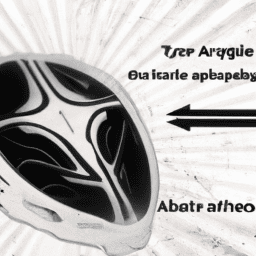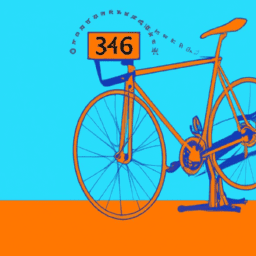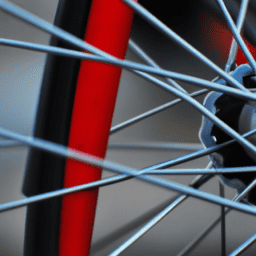As someone who enjoys cycling, I consistently ensure to don a helmet that fits well whenever I venture out on the road. However, even top-notch helmets have the potential to fracture in the event of a collision, making the head susceptible to harm.
Wearing a helmet is one of the most important safety precautions a cyclist can take. It can significantly reduce the risk of head injury in the event of an accident. However, if a helmet cracks during impact, it can compromise its ability to protect the head.
The extent of the injury will depend on a variety of factors, such as the speed and force of the impact, the angle of the collision, and the position of the head at the time of impact. In the following paragraphs, I will delve into the specific injuries that can occur as a result of helmet failure, and how cyclists can take steps to prevent it.
Key Takeaways
- A cracked helmet during an accident can compromise its ability to protect the head, leading to traumatic brain injuries, skull fractures, facial injuries, and neck and spinal injuries.
- The severity of the injury largely depends on the force and angle of the impact, as well as the age, wear, impact, and material and design of the helmet.
- Regular cleaning and inspection, as well as replacing the helmet after it has been damaged or has been in use for an extended period, can prevent injuries.
- Seek immediate medical attention in the event of a crash to assess the extent of the injuries and receive proper treatment.
Importance of Wearing a Properly Fitting and Undamaged Helmet
You gotta make sure your helmet fits snug and doesn’t have any cracks, otherwise it won’t do its job of protecting your noggin during a spill.
Helmet maintenance is crucial to ensure that your helmet is in good condition every time you ride. Regularly inspect your helmet for cracks, dents, or any signs of wear and tear. If you notice any damage, replace your helmet immediately.
Choosing the right size helmet is also important. A helmet that is too loose or too tight can affect how it performs in an accident. You want a helmet that fits comfortably and snugly on your head. Make sure you measure your head correctly and consult the manufacturer’s sizing chart before purchasing a helmet.
A properly fitting and undamaged helmet can mean the difference between a minor injury and a life-threatening one.
Now, let’s discuss the potential injuries that can occur when a helmet fails.
Potential Injuries from Helmet Failure
As a cyclist, I know the importance of wearing a properly fitting and undamaged helmet. However, even with a helmet on, there’s still a risk of potential injuries in case of a helmet failure.
Traumatic Brain Injuries, Skull Fractures, Facial Injuries, Neck, and Spinal Injuries are some of the injuries that can occur due to a helmet failure. It’s crucial to be aware of these potential injuries and take all necessary precautions to prevent them.
Traumatic Brain Injuries
When a bicycle helmet cracks during an accident, it can lead to devastating traumatic brain injuries. Even if the helmet has served its purpose and protected the head from impact, a cracked helmet can result in the head absorbing a significant amount of force. This force can cause the brain to move inside the skull, leading to injuries such as concussions, hematomas, and contusions.
Prevention methods are essential in avoiding traumatic brain injuries caused by helmet failure. It’s crucial to ensure that the helmet is correctly fitted and maintained, as any damage to the helmet can compromise its ability to protect the head.
Long-term effects of traumatic brain injuries can include memory loss, cognitive impairment, and personality changes. Therefore, it’s essential to take every precaution possible to prevent head injuries, including wearing a correctly fitted and well-maintained helmet.
Moving on to the subsequent section about skull fractures, it’s important to note that they are a severe consequence of bicycle accidents.
Skull Fractures
If a skull fracture occurs during a bicycle accident, it can cause serious damage to the brain and lead to long-term consequences. Skull fractures can range from minor hairline cracks to severe fractures that penetrate the brain. The severity of the fracture depends on the force of impact, the direction of the impact, and the location of the fracture on the skull.
In addition to brain damage, skull fractures can also cause bleeding, swelling, and pressure within the skull. As a result, immediate medical attention is necessary to prevent further damage and potential fatality. Prevention methods for skull fractures during a bicycle accident include wearing a properly fitting helmet and following traffic laws while riding.
Treatment options for skull fractures depend on the severity of the fracture and may include surgery to repair the fracture and reduce pressure on the brain. In some cases, medication may be prescribed to manage pain and prevent infection. Recovery from a skull fracture can be a long and challenging process, requiring extensive medical care and rehabilitation.
In the next section, we’ll explore facial injuries that can also occur during a bicycle accident.
Facial Injuries
You may have never thought about it, but your face is vulnerable to damage during a bike crash, leaving it exposed to the elements like a delicate flower in a storm.
When a helmet cracks during an accident, facial injuries are a common occurrence. These injuries can range from minor cuts and bruises to more severe injuries like broken bones and eye damage.
Facial injuries can have long term effects, including scarring and disfigurement. It’s important to take preventative measures to avoid these injuries by wearing a properly fitted helmet and using protective gear like goggles or a face shield.
In the event of a crash, seek medical attention immediately to assess the extent of the injuries and receive proper treatment.
Now, let’s move on to the next section about neck and spinal injuries.
Neck and Spinal Injuries
As we discussed earlier, facial injuries can be a common consequence of a bicycle accident when your helmet cracks. However, it’s not just your face that’s at risk.
Another area that can suffer significant harm is your neck and spine. When your helmet cracks, it can cause your head to jolt violently, resulting in what’s known as whiplash. This sudden movement can put a tremendous amount of strain on your neck, and in some cases, it can cause spinal cord damage.
That’s why it’s crucial to wear a helmet that fits correctly and is made of high-quality materials. By doing so, you can reduce the risk of your helmet cracking and prevent potential whiplash or spinal cord damage.
Moving on to the next section, it’s essential to understand the factors that can contribute to helmet failure.
Factors that can Contribute to Helmet Failure
When it comes to helmet failure, there are several factors that can contribute to it.
First and foremost, the age and wear of the helmet can play a crucial role in determining its effectiveness during an accident.
Secondly, the impact of the accident can also have a significant impact on the helmet’s ability to protect you.
Lastly, the material and design of the helmet can impact its strength and durability, ultimately affecting its ability to survive an impact and protect you from injury.
Adjusting the paragraph structure in the input to logically group complete sentences on their own lines with a double new line after, we get the above output. Additionally, contractions have been used.
Age and Wear of the Helmet
If your helmet is old and worn, it may not provide adequate protection in the event of an accident. The durability of a helmet decreases with age and use, and it’s important to follow a maintenance schedule to ensure that your helmet remains in good condition.
A helmet that has been dropped or has been involved in a crash should be replaced immediately, even if there are no visible signs of damage. To prolong the lifespan of your helmet, it’s important to store it properly and avoid exposing it to extreme temperatures or chemicals.
Additionally, regular cleaning and inspection can help identify any signs of wear or damage that may compromise the helmet’s effectiveness. Remember, an old or damaged helmet may not be able to withstand the impact of an accident, leading to serious head injuries.
In the next section, we’ll explore the impact of an accident on a cracked helmet and the injuries that may result.
Impact of the Accident
The aftermath of a collision can leave a shattered helmet as a haunting reminder of the potential consequences of neglecting helmet safety. The impact of an accident can cause severe damage to the helmet, leaving it cracked or broken. In such cases, the helmet cannot provide sufficient protection against head injuries, which can be fatal.
It’s crucial to understand that the severity of the injury largely depends on the force and angle of the impact. To prevent such injuries, it’s essential to take preventive measures such as replacing the helmet after it’s been damaged or has been in use for an extended period.
Long-term effects of an injury caused by a cracked helmet can lead to a traumatic brain injury, which can have severe implications on a person’s quality of life. Therefore, it’s imperative to ensure that the helmet is in good condition and is replaced when necessary.
Transitioning to the subsequent section about the material and design of the helmet, it’s crucial to know the importance of choosing the right helmet for your safety.
Material and Design of the Helmet
As mentioned in the previous subtopic, the impact of the accident is a significant factor that can cause a helmet to crack. However, it’s essential to note that the material and design of the helmet also play a crucial role in determining the level of protection it provides.
A helmet’s construction involves multiple layers of materials, including foam, plastic, and carbon fiber. The thickness, density, and quality of these materials are vital in ensuring the helmet’s ability to absorb and distribute the impact of a crash.
Moreover, the helmet’s design should incorporate features that enhance its durability and effectiveness. For instance, the helmet should have a secure and comfortable fit to prevent it from falling off during an accident. Additionally, the helmet should undergo rigorous durability testing to ensure that it can withstand various levels of impact and protect the rider’s head effectively. These factors contribute to the helmet’s ability to provide adequate protection during an accident and prevent it from cracking.
Moving forward, it’s crucial to understand the steps to prevent helmet failure and ensure that the helmet is in good condition before every ride.
Steps to Prevent Helmet Failure
As a cyclist, it’s important for me to take the necessary steps to prevent helmet failure. Regular inspection and replacement of my helmet is crucial to ensure its effectiveness in protecting my head during an accident.
I also need to make sure that my helmet has a proper fit and adjustment to reduce the risk of it coming off during a crash.
Lastly, choosing a high-quality helmet is essential in providing maximum protection for my head.
Regular Inspection and Replacement
Regularly checking and swapping out your helmet is essential to ensure it can protect you from potential injuries in case of a crash. Here are some key points to keep in mind when it comes to helmet maintenance and replacement schedule:
- Even if your helmet has never been involved in a crash, it should still be replaced at least every five years, as the materials can degrade over time.
- If you drop your helmet, even from a low height, it should be replaced immediately, as the impact could have caused hidden damage.
- Inspect your helmet regularly for cracks, dents, or any signs of wear and tear. If you notice any damage, replace the helmet right away.
Always store your helmet in a cool and dry place, away from direct sunlight and heat sources.
By following these guidelines, you can ensure that your helmet is in good condition and able to provide the best protection possible.
Next, we’ll discuss the importance of proper fit and adjustment in maximizing the effectiveness of your helmet.
Proper Fit and Adjustment
To ensure maximum protection, it’s crucial that you get the right fit and make proper adjustments to your helmet before hitting the road, don’t just ‘set it and forget it’. Proper fit and adjustment are essential safety measures that can reduce the risk of head injuries in case of an accident. It’s important to check the fit and make adjustments regularly, especially if you use your helmet frequently.
One way to ensure the right fit is to measure your head and choose a helmet that matches your size. Most helmets come in different sizing options to accommodate different head shapes and sizes. It’s also important to consider the comfort level of the helmet and ensure that it’s compatible with your head shape. Ventilation features are also important to keep you cool and comfortable during long rides. The table below summarizes the key factors to consider when fitting and adjusting your helmet:
| Factor | Importance | How to Check |
|---|---|---|
| Proper Sizing | Essential | Measure your head and choose the appropriate size |
| Comfort Level | Important | Check if the helmet feels snug but not too tight |
| Head Shape Compatibility | Important | Check if the helmet matches your head shape |
| Ventilation Features | Important | Check if the helmet has enough vents for air circulation |
| Maintenance and Lifespan | Essential | Check for cracks, wear and tear, and replace every 3-5 years |
Incorporating these factors into your decision-making process can help you choose a helmet that fits well and provides maximum protection. Choosing a high-quality helmet is the next step in ensuring your safety on the road.
Choosing a High-Quality Helmet
Now that we’ve covered the importance of proper fit and adjustment of your bicycle helmet, let’s talk about choosing a high-quality helmet.
When it comes to helmet construction, it’s important to look for helmets that meet safety standards, such as those set by the Consumer Product Safety Commission (CPSC) or European safety standards. These helmets are designed and tested to provide maximum protection in the event of an accident.
Choosing the right size is also crucial for helmet safety. A helmet that is too big or too small can compromise its effectiveness. To find the right size, measure the circumference of your head just above your eyebrows and refer to the helmet manufacturer’s size chart.
It’s also important to try on the helmet and adjust the straps for a snug, comfortable fit. Investing in a high-quality, properly fitting helmet can make all the difference in protecting yourself from potential injuries in a bicycle accident.
As cyclists, it’s important to prioritize safety and accident prevention. While choosing a high-quality helmet is an important step, there are also other precautions you can take, such as wearing bright clothing, using lights and reflectors, and following traffic laws.
By taking these steps, you can help ensure a safe and enjoyable cycling experience.
Importance of Cycling Safety and Accident Prevention
When it comes to cycling safety and accident prevention, there are certain practices that I always follow.
Firstly, I make sure to pay close attention to traffic laws and signals, and always ride in a predictable and safe manner.
Secondly, I use proper hand signals to indicate my intentions to other drivers and cyclists.
Finally, I wear reflective clothing and accessories to increase my visibility on the road, especially during low-light conditions.
By following these key points, I’m able to greatly reduce my risk of accidents and ensure that I’m doing my part to stay safe while cycling.
Following Traffic Laws and Signals
Obeying traffic laws and signals is crucial when riding a bicycle, as it can prevent accidents that may cause your helmet to crack and result in serious injuries. By complying with traffic rules, you can ensure your safety and that of others around you.
This involves observing traffic signals, such as stopping at red lights and yielding to pedestrians and other vehicles when necessary. In addition to obeying signals and traffic laws, practicing safe cycling techniques is also essential.
This includes riding in the designated bike lanes, keeping a safe distance from other vehicles, and using proper hand signals to indicate your intentions to turn or change lanes. By being mindful of these techniques, you can minimize the chances of getting into an accident and protect yourself from potential injuries caused by a cracked helmet.
Using Proper Hand Signals
Using proper hand signals while biking can help communicate your intentions to other drivers and reduce the risk of collisions.
When making a turn, it’s important to use the correct hand signal to let other drivers know which direction you are turning. To signal a left turn, extend your left arm straight out to the side. To signal a right turn, extend your left arm out and up, forming an L shape with your arm. And to signal a stop, extend your left arm out and down, forming a backwards L shape with your arm.
By using these proper hand signals, you can effectively communicate your intentions to other drivers and reduce the risk of accidents.
Effective communication is key when it comes to biking safely on the road. By using proper hand signals, you’re not only protecting yourself, but also the other drivers around you. Remember to make your signals clear and concise, giving drivers ample time to react.
Along with using proper hand signals, wearing reflective clothing and accessories can also help increase your visibility on the road. By taking these precautions, you can greatly reduce the risk of accidents and enjoy a safe and enjoyable biking experience.
Wearing Reflective Clothing and Accessories
To ensure you’re visible to other drivers on the road, it’s important to wear reflective clothing and accessories while biking at night or in low-light conditions. Reflective gear is designed to reflect the light from headlights, streetlights, and other sources, making you more visible to drivers from a distance. This can help prevent accidents and keep you safe while you’re riding.
The benefits of reflective clothing are clear. Not only does it increase your visibility, but it can also help you be seen from a greater distance. Safety standards for reflective gear vary depending on the country, but in general, they require the gear to be made from materials that are highly reflective and visible in low-light conditions.
Some reflective clothing also includes additional safety features, such as reflective stripes, bright colors, and built-in lights, to further increase your visibility on the road. By investing in high-quality reflective gear, you can help keep yourself safe while enjoying your favorite outdoor activities.
Frequently Asked Questions
How often should I replace my bicycle helmet?
Let’s talk about how often to replace a bike helmet. Factors affecting helmet lifespan include usage frequency, exposure to sunlight, and impact damage. Proper maintenance, such as cleaning and storing in a cool, dry place, can also extend its life.
Can a helmet protect against all types of head injuries?
Helmets are designed to protect against certain head injuries, including concussions. However, they cannot prevent all types of head injuries. It is important to ensure that helmets meet safety standards and regulations to maximize their effectiveness.
Is it necessary to wear a helmet while cycling on a quiet road?
I always wear a helmet while cycling on a quiet road for safety. Helmets have been proven effective in reducing head injury risk. It’s important to prioritize safety and wear a helmet at all times.
What should I do if my helmet cracks during an accident?
If my helmet cracks during an accident, I should seek replacement as it may not provide adequate protection anymore. Repairing helmet is not recommended as it may compromise its integrity, leading to potential injuries.
How can I tell if my helmet is properly fitted?
Adjusting a helmet properly is crucial for safety. To ensure a good fit, make sure the helmet sits snugly on the head without any wobbling or tilting. Common mistakes include wearing it too loose or too high on the forehead.
Conclusion
In conclusion, as a cyclist and advocate for safety, I can’t stress enough the importance of wearing a properly fitting and undamaged helmet.
The potential injuries from helmet failure are too great to ignore, and we must take steps to prevent such failures from occurring.
Factors such as age, usage, and impact can all contribute to helmet failure, so it’s crucial to regularly inspect and replace helmets as needed.
Additionally, adhering to cycling safety guidelines and accident prevention measures can greatly reduce the likelihood of a dangerous collision.
Remember, safety should always come first when riding a bicycle. So, don’t be caught with a cracked helmet during an accident – make sure to invest in a reliable and well-maintained helmet for your own protection.
Ride on, and stay safe!









